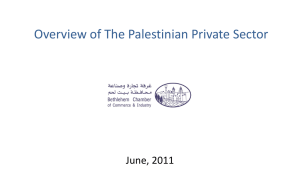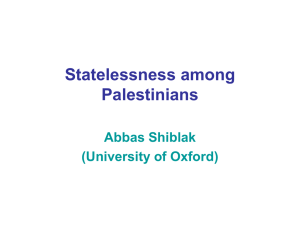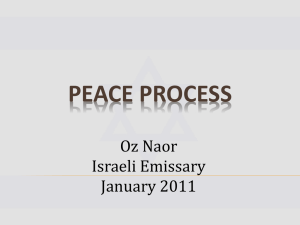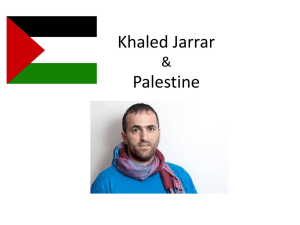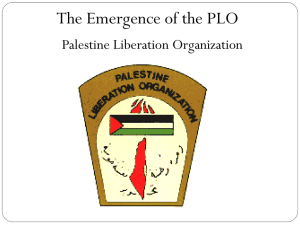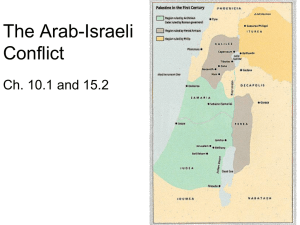UNCTAD United Nations Conference on Trade and Development
advertisement
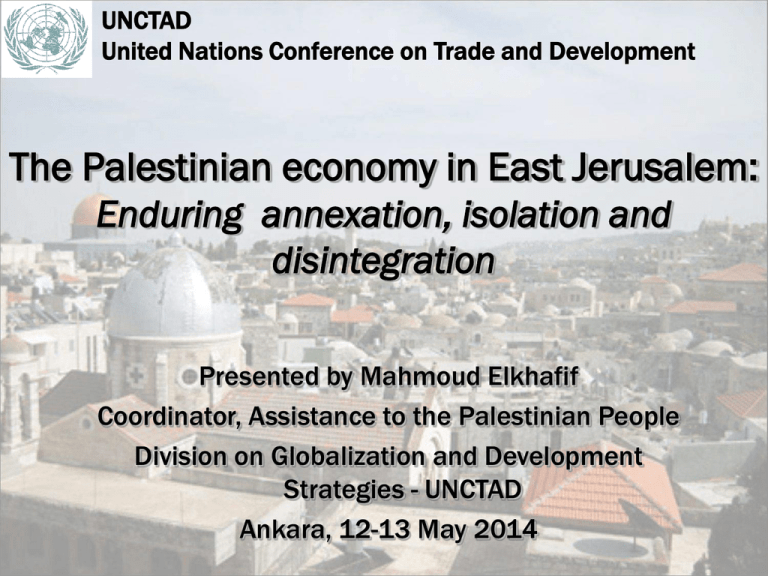
UNCTAD United Nations Conference on Trade and Development The Palestinian economy in East Jerusalem: Enduring annexation, isolation and disintegration Presented by Mahmoud Elkhafif Coordinator, Assistance to the Palestinian People Division on Globalization and Development Strategies - UNCTAD Ankara, 12-13 May 2014 United Nations Conference on Trade and Development - UNCTAD THE EJ ECONOMY IN A “DEVELOPMENT LIMBO” - Unique place in Palestinian and world history - Differential legal status from rest of the OPT - Physical and demographic segregation east and west - Macroeconomic decline, isolation, dysfunction - Microeconomic survival amidst disintegration - Severe poverty and labour market fragmentation - Social fabric at risk: sub-standard conditions and services - Strategies for EJ development cooperation United Nations Conference on Trade and Development - UNCTAD UNIQUE PLACE IN PALESTINIAN AND WORLD HISTORY • Centrality to the history and tenets of Islam, Christianity and Judaism. • Since division in 1948 a bleak history to narrate - contentious moral, historical and political debates. • 1922–1948: administrative and political capital of the Mandate for Palestine. • 29 November 1947: General Assembly (GA) resolution 181 (II), partition of Palestine into two States -- Jerusalem as a corpus separatum under a special international regime, with the United Nations Trusteeship Council to administer the city and to conduct its external affairs. • GA resolution 303 (1949) requested the Trusteeship Council to prepare for administering Jerusalem on the lines of resolution 181 (II). • 1950: the Trusteeship Council approved the Statute for the City of Jerusalem, along the principles embodied in resolution 181 (II). United Nations Conference on Trade and Development - UNCTAD DIFFERENTIAL LEGAL STATUS FROM REST OF OPT • As early as 1967, the United Nations General Assembly and Security Council rejected Israel’s occupation and annexation of East Jerusalem. • UN resolutions have since affirmed the illegality of the occupation of EJ along with the rest of the Palestinian territory occupied in 1967and called for Israel’s withdrawal from EJ and an end to its settlement activities. • SC Resolution 476 of 1980: all legislative and administrative measures and actions taken by the occupying Power, which purported to alter the geographic, demographic and historical character and status of the Holy City of Jerusalem had no legal validity, were null and void. • Israeli-Palestinian Oslo Accords: permanent status issue of Jerusalem postponed to the end of the five-year interim period. Camp David negotiations addressed Jerusalem in detail, final agreement elusive. United Nations Conference on Trade and Development - UNCTAD PHYSICAL AND DEMOGRAPHIC SEGREGATION EAST AND WEST • Israeli occupation began in 1967 with the redefinition of the municipal boundaries for Jerusalem and the annexation of EJ. • Segregation strategies have become more pervasive during the last decade through measures that have altered the physical and demographic realities of the city and its predominantly Palestinian landscape. • Palestinian Jerusalemites of annexed EJ are classified as permanent residents, with the rights to live and work in Israel. Residency permit could be revoked at any time, according to Israeli laws and various restrictive provisions that are apply to them. • 1967 to 1994: more than 140,000 OPT Palestinians have lost their residency rights, 14,000 in EJ alone. Now 14,000 families and 50,000 persons. • 2010: 362,000 Jerusalemites, of whom 282,000 inside the Barrier. • Separate and restricted access to housing: Only 13% of the annexed zone of EJ designated for Palestinian housing as compared to triple that area designated for Israeli settlers. United Nations Conference on Trade and Development - UNCTAD PHYSICAL AND DEMOGRAPHIC SEGREGATION EAST AND WEST • High municipal and property taxes - very little services and low municipal expenditure on EJ: Palestinian neighbourhoods host 30% of the city’s population received only 7% of the municipal budget in 2009. • Shrinking demand from Palestinian consumers has been a major factor in the closure of 280 shops in EJ during since 1997, 50 in the Old City alone. • Marketing opportunities were also lost to EJ producers with the tight restrictions on the entry of Palestinians who live in the rest of OPT and who used to be an important component of demand for EJ goods and services. • EJ lost access to relatively cheap products from the West Bank due to restrictions on movement of goods and complex, expensive trade permits. United Nations Conference on Trade and Development - UNCTAD PHYSICAL AND DEMOGRAPHIC SEGREGATION EAST AND WEST • Separation Barrier redefined the borders away from the pre-1967 internationally recognized borders. It caused unabated hardships, curtailing economic, civic and social rights for both Palestinian communities encircled in and outside the wall. • By 2010, 201,000 settlers living in 16 settlements and suburbs within the Barrier, a population almost as large as the Palestinian population of the city. • 55,000 Jerusalemites - fifth of the EJ Palestinian population - physically separated from the city centre as a result of the Barrier. Live within the Municipality and pay municipal taxes but do not all enjoy services. • East Jerusalem markets and furthered internal market disarticulation. • By 2010, it is estimated that the Barrier incurred over one billion dollars in direct losses to Palestinian residents in Jerusalem - adverse impact in terms of lost opportunities at the rate of $200 million per year. United Nations Conference on Trade and Development - UNCTAD MACROECONOMIC DECLINE, ISOLATION, DYSFUNCTION • EJ share of Palestinian GDP halved in 25 years: from 15% prior to the first intifada, to above 8% in the mid-1990s - under 7% in recent years. • Services sector remains the largest sector in both the economies of EJ and the remaining OPT, contributing on average around 40% in EJ. • Some economic sectors contribute in a similar manner to GDP in EJ and the remaining OPT (internal trade and manufacturing). • Other economic sectors play differential roles: hotel and restaurant activities are less significant in the economy of the remaining OPT, as compared to EJ; transportation has higher weight in the economy of EJ than in that of the remaining OPT; construction has greater weight in the rest of WB than EJ. United Nations Conference on Trade and Development - UNCTAD MICROECONOMIC SURVIVAL AMIDST DISINTEGRATION • Palestinian households and businesses in EJ face impediments related to access to finance and credit • Problem not merely the lack of bank branches in EJ: Palestinians avoid relying on Israeli banks for mortgages, business financing or transfers. Instead, they use Palestinian banks operating outside the Barrier, but which do not accept real estate guarantees from Jerusalemites. • Deposits in Palestinians banks of EJ residents amount to about $200 million, but banks operating in OPT do not provide housing loans unless the clients are from Palestinian Authority-controlled areas of East Jerusalem (J2). • Strong “integrative” forces of adaptation to the Israeli regulatory framework and exchange with the Israeli economy exert a powerful pull on Jerusalemites to conform and acquiesce under Israeli rule. United Nations Conference on Trade and Development - UNCTAD SEVERE POVERTY AND LABOUR MARKET FRAGMENTATION • The higher unemployment and poverty rates among Palestinian Jerusalemites, compared to Israelis residing in the City, attest to their marginalization within the Israeli economy and the simultaneous separation from trends in the rest of the OPT – another feature of the “limbo”. • Higher wages of workers in Israel have exerted upward pressure on wages in EJ, increasing labour cost to Palestinian producers despite low productivity. This undermines the competitiveness of EJ products and services, which are increasingly substituted with imports, mainly from Israel. United Nations Conference on Trade and Development - UNCTAD SEVERE POVERTY AND LABOUR MARKET FRAGMENTATION • Palestinians are about 30% of the total population of the city, but they form 43% of the unskilled labour force. • Facing the same cost of living and market conditions as Israelis in Jerusalem, the average monthly wage for EJ Palestinians working in Israel was NIS 4,032 in 2009 - less than half the average in Israel – NIS 8,131. • The poverty rate in EJ has been rising over the last decade: 77% of nonJewish households in Jerusalem were under the Israeli poverty line, compared to 25% for Israeli households in Jerusalem. • 84% of Palestinian children were classified as poor in comparison to 45% of Jewish children in the city. • Palestinians are a third of the city's population but only three welfare offices operate in EJ in contrast to 18 in Jerusalem serving Israelis. United Nations Conference on Trade and Development - UNCTAD SUB-STANDARD SERVICES – EDUCATION AN EXAMPLE • In the academic year 2007/2008, shortage of at least 1,000 classrooms in EJ at all levels and only 257 classrooms had been added since 2001. • Half (704) of EJ classrooms “substandard” in 2009, 221 in “unfit” buildings. • Schooling in bordering communities of the West Bank can jeopardize residency rights in the city for students. • 5,000 Palestinian school-age children are not enrolled in any institution. • Israeli WJ has a 7.4% dropout rate, in EJ the rate is a staggering 50 %. • Lack of recreational and cultural services and outlets: WJ has 1,000 public parks - only 45 in EJ; 34 swimming pools - 3 in EJ; 26 public libraries - 2 libraries in EJ; 531 sports facilities - 33 in EJ. • Differential budget allocation for elementary school students: in EJ estimated at NIS 577 per student, less than ¼ the per-student budget allocated in WJ. United Nations Conference on Trade and Development - UNCTAD STRATEGIES FOR EJ DEVELOPMENT COOPERATION • While occupation is the root for the lack of development and poor economic growth and poverty, UNCTAD highlights several areas that call for action. • Were it so inclined, Israel could go much further in meeting its obligations by acting with vigour to improve the economic conditions in EJ and to end discrimination against Palestinian Jerusalemites, beginning with residency rights, municipal services, social welfare and housing. • International assistance should be coordinated well among agencies and closely with the private sector and non-governmental social service providers in EJ as well as the PA, despite the jurisdictional vacuum in WJ, and with provision of to target specific economic sectors. • Israeli official neglect of the EJ’s dire socioeconomic conditions calls for a creative and flexible approach that makes the best of the legal opportunities to protect, sustain and nurture Palestinian livelihoods in EJ, especially alleviating hardship in the Old City. United Nations Conference on Trade and Development - UNCTAD STRATEGIES FOR EJ DEVELOPMENT COOPERATION - To safeguard East Jerusalem’s critical role as the capital city of a Palestinian State, useful indicative planning in 2010-2011 by PA to guide investment and rebuild the city’s economic infrastructure. - A mix of investments by government, private sector and donors is envisioned, allocated among clusters reflecting broadly the key socioeconomic challenges in EJ today: social protection, economic development and human rights. - Economic development needs are identified in three sectors: the economy ($77 million), tourism ($127 million) and housing ($124 million). - UNCTAD also suggests devising alternative sources and sustainable mechanisms for financing investment, housing and other productive activities, to facilitate economic, social and political cohesion of Palestinian Jerusalemites despite continued occupation. United Nations Conference on Trade and Development - UNCTAD STRATEGIES FOR EJ DEVELOPMENT COOPERATION • Palestinian Jerusalemite NGOs, social and religious institutions and civic groups could do more to enhance their coordination with each other and with the PA and other authorities. • They also need to maintain unity of vision and coherence of action, given the many divisive forces operating in their midst. • Taking into account the multiple jurisdictions and government authorities with which Palestinians in EJ must maintain their legitimacy, the challenge of simply remaining a Jerusalemite is in itself a development strategy. • Building economic links with PA employers and investors, clients/markets preserves historic economic relations. This also offers Palestinians in EJ attractive alternatives to second and third class status in the Israeli labour market and

